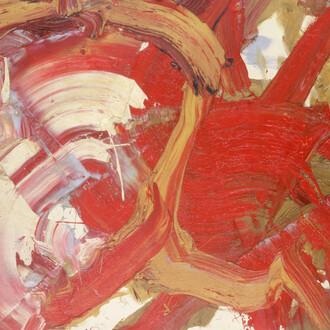Fergus McCaffrey is pleased to present a solo exhibition of paintings by Toshio Yoshida (1928–97), featuring three early bodies of work made by the innovative artist between 1953–63. Yoshida was one of the founding members of the Japanese avant-garde collective Gutai, and this exhibition provides an intimate look at Yoshida’s artistic production during the height of Gutai’s activity. This focused exhibition, which will be on view from November 3 – December 29, 2018, marks Fergus McCaffrey’s first presentation of Yoshida’s work at the gallery’s Tokyo location.
Beginning in the early 1950s, Yoshida abandoned traditional oil painting methodologies to experiment with radical materials and forms, following Gutai founder Jiro Yoshihara’s injunction to “do what has never been done before.” Yoshida’s earliest experiments reveal an imaginative, ambitious young artist: in a remarkable early painting, Untitled (1953), Yoshida spread a thin layer of paint atop board using a palette knife to create fan-like gestures in black and white oil. This work blends a Cubist sensibility with the artist’s unique material technique, prefiguring Gerhard Richter’s scraper paintings. In Untitled (54-6) (1954), one of the highlights of the exhibition, the artist disrupts the vibrant red painted surface with a diagonal grouping of metal hooks screwed into the wood surface, collapsing the boundary between fine art and industrial materials. Another untitled canvas from 1956 further shows the artist’s capacity for material and conceptual experimentation: Yoshida layered thick cement directly on top of board, then painted a black “frame” adding a vibrant blue “ground” outlining the dense concrete, resulting in a reverse strategy for the tradition of figure exchange in painting.
In 1954 at the same time as these early material experiments, Yoshida began work on a series of Burn Paintings. He created these by pressing a soldering iron or red-hot coals to plywood panels, leaving intricate patterns of searing and scarring marks. These works, three of which are on view in Fergus McCaffrey’s Tokyo exhibition, are remarkable for their complex but harmonious compositions, and recall ancient East Asian ink-wash paintings as well as psychoanalytic “automatic” drawings made by the French Surrealists. Yoshida’s pioneering explorations of the expressive potential of fire in painting predate Alberto Burri’s first Combustione paintings (1955) and Yves Klein’s Fire paintings of 1957. The Burn Paintings were central to Yoshida’s idea of “creative destruction”; like many Gutai members, the artist wanted to abandon traditional modes of artmaking in the wake of the Second World War, moving forward with renewed attention to forms of potential and possibility available in the aftermath of wartime violence.
During Gutai’s formative first years, Yoshida extensively investigated action, simultaneity, and performance, often working in theatre to develop ideas he would go on to pursue in painting. As Michel Tapié’s influence on Gutai took hold in the late 1950s, painting came more and more to the fore. In the next decade, Yoshida translated his ideas into materially challenging paintings, placing an even greater emphasis on rigorous interrogation of the form. To do so, he often turned to ideas he had first articulated onstage. For example, at the 1956 Second Gutai Art Exhibition, Yoshida poured India ink from a watering can onto a canvas from a distance of ten feet. Years later, he revisited this theatrical technique in works such as Untitled (1963), which features droplets and splashes of white paint radiating in linear patterns atop a base of heavily textured papier-mâché.
Similarly, Yoshida first examined ideas of layering and framing in his installation Shadow at the 1957 Gutai Art on the Stage, which consisted of objects placed onstage with electric lights illuminating them to cast shadows onto the curtain behind them. He continued to explore these ideas in the following decade, as demonstrated in Untitled (1962), on view in the Tokyo exhibition. Here, the artist uses a similar technique in paint as he did in physical space, illuminating and shadowing the work’s surface with various layers of pigment. The resulting concentric rectangular shapes bring to mind a theatrical stage or a painting frame; in this way, the painting interrogates its own capacity for representation. Unlike many of Yoshida’s works made during the 1960s, which feature somber monochromatic hues, Untitled (1962) vibrates with bright and intense moments of color.















